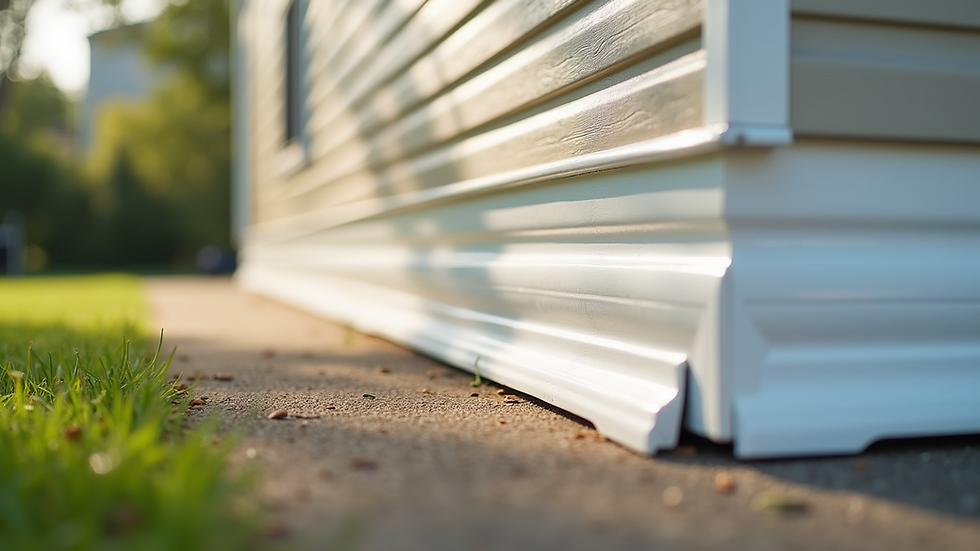Effective Repairs for Mobile Home Skirting
- Lone Star Mobile Home
- Sep 14
- 4 min read
Mobile home skirting plays a crucial role in protecting the underside of your home from pests, weather damage, and energy loss. Over time, skirting can become damaged due to weather conditions, accidental impacts, or natural wear and tear. Knowing how to effectively repair or replace your mobile home skirting can save you money and maintain the structural integrity of your home.
Understanding Mobile Home Skirting Replacement
Mobile home skirting replacement involves removing old or damaged panels and installing new ones to restore the protective barrier around the base of your home. Skirting materials vary widely, including vinyl, metal, wood, and composite options. Each material has its own benefits and maintenance requirements.
When considering replacement, it is important to assess the extent of the damage. Minor cracks or holes might be repaired, but extensive damage or rotting usually calls for full replacement. Proper installation ensures that the skirting is secure, ventilated, and resistant to moisture buildup.
Key steps in mobile home skirting replacement include:
Measuring the perimeter of your home accurately.
Selecting the right skirting material for your climate and budget.
Preparing the ground and foundation for installation.
Installing panels with proper ventilation gaps.
Sealing edges to prevent water intrusion.

Signs You Need Mobile Home Skirting Repair or Replacement
Identifying when your skirting needs attention is essential to prevent further damage. Here are common signs that indicate repair or replacement is necessary:
Visible cracks or holes: These allow pests and moisture to enter.
Warping or bending: Often caused by water damage or impact.
Loose or missing panels: Can compromise insulation and protection.
Mold or mildew growth: Indicates moisture trapped behind skirting.
Rodent or insect infestation: Skirting gaps provide easy access.
Ignoring these signs can lead to costly repairs to your home’s foundation or flooring. Regular inspections, especially after storms or harsh weather, help catch problems early.
Can you repair mobile home skirting?
Yes, many types of mobile home skirting can be repaired depending on the damage. Small holes or cracks can be patched using appropriate materials such as vinyl patch kits or metal fillers. Loose panels can be re-secured with screws or clips.
For wood skirting, damaged boards can be replaced individually without removing the entire skirting. Cleaning and treating mold or mildew with anti-fungal solutions can restore the appearance and safety of the skirting.
However, if the damage is widespread or the skirting is old and deteriorated, replacement is often more cost-effective and durable. Repairing minor issues promptly extends the life of your skirting and maintains your home’s energy efficiency.

How to Perform Mobile Home Skirting Repair Safely and Effectively
When undertaking mobile home skirting repair, safety and proper technique are paramount. Here are practical steps to guide you through the process:
Inspect and assess damage: Identify all areas needing repair.
Gather tools and materials: Common tools include a drill, screws, patch kits, sealant, and replacement panels if needed.
Remove damaged sections: Carefully detach broken panels or boards.
Prepare the surface: Clean the area and remove debris or mold.
Apply patches or replace panels: Use manufacturer-recommended materials for best results.
Secure panels firmly: Ensure panels are flush and fastened tightly.
Seal edges and gaps: Use weatherproof sealant to prevent moisture entry.
Check ventilation: Maintain proper airflow to avoid condensation buildup.
If you are unsure about the repair process or the damage is extensive, consulting a professional is advisable. Proper repair not only improves appearance but also protects your home’s foundation and energy efficiency.
For more detailed guidance and professional services, consider exploring mobile home skirting repair.
Maintenance Tips to Extend the Life of Your Mobile Home Skirting
Regular maintenance is key to prolonging the life of your skirting and avoiding costly repairs. Here are some actionable tips:
Clean skirting regularly: Remove dirt, leaves, and debris to prevent moisture buildup.
Inspect after storms: Check for damage caused by wind, hail, or falling branches.
Trim vegetation: Keep plants and bushes away from skirting to reduce moisture and pest risks.
Check for pests: Look for signs of rodents or insects and address infestations promptly.
Repaint or reseal wood skirting: Protect wood from weathering by applying sealants or paint every few years.
Ensure proper drainage: Make sure water flows away from the base of your home to prevent pooling.
By following these maintenance practices, you can keep your mobile home skirting in good condition and avoid premature replacement.

Choosing the Right Skirting Material for Replacement
Selecting the right material for your mobile home skirting replacement depends on your budget, climate, and aesthetic preferences. Here are common options:
Vinyl: Affordable, low maintenance, and resistant to moisture and pests.
Metal: Durable and strong, but may dent or rust over time.
Wood: Offers a natural look but requires regular maintenance and is susceptible to rot.
Composite: Combines durability with low maintenance, often mimicking wood appearance.
Consider factors such as insulation properties, ease of installation, and local weather conditions when choosing your skirting material. Consulting with a professional can help you make the best choice for your home.
Taking care of your mobile home skirting through timely repairs and proper replacement ensures your home remains protected and energy-efficient. Whether you choose to repair minor damage or replace the entire skirting, following best practices will keep your home safe and looking great for years to come.


